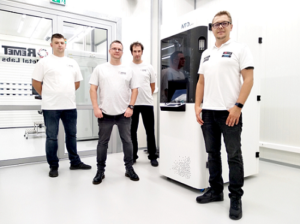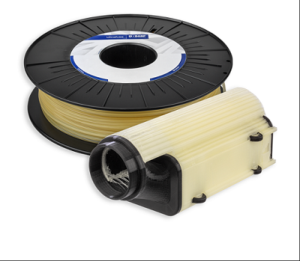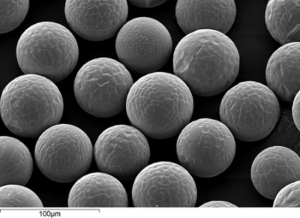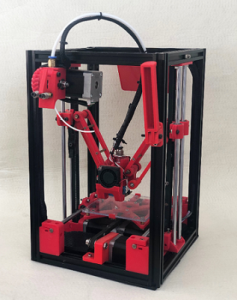The stories we’re sharing in today’s 3D Printing News Briefs run the gamut from materials to new printers. Altair has launched its new industrial design solution, and Remet opened a metal 3D printing lab in Poland. Innofil3D is sharing lots of material news, and Equispheres has released the test results for a unique 3D printing powder. Finally, Hackaday published a micro 3D printer project.
Altair Launches New Industrial Design and Rendering Solution

The “Geko Ring Collection,” jewelry by Luca Palmini, designed and rendered with Inspire Studio. Image courtesy of Luca Palmini.
Global technology company Altair has launched Inspire Studio, its new 3D design and rendering solution, to help architects, designers, and digital artists create, evaluate, and visualize designs. The solution builds on the functions of Altair Evolve, and includes 3D rendering and animation software Inspire Render, which helps users rapidly generate photorealistic product renderings and animations. Both Inspire Studio and Inspire Render run on MacOS and Windows, and help designers open up their creativity to go beyond traditional CAID tools. The solutions will be introduced next month during a one-day launch event in Italy, and you can also get a free ticket to formnext 2019, where you can learn more about Inspire Studio and Inspire Render at Altair’s booth E11, hall 11.1.
“We are very pleased with these two new solutions for the global industrial design community. Inspire Studio builds on our previous industrial design tool, Evolve, while going beyond Evolve’s capabilities. Inspire Studio will enhance designers’ creativity by letting them drive their designs. It offers an intuitive user interface and a powerful construction history, allowing them to quickly create and explore multiple iterations of their design. Relying on the same modern user experience with powerful interactive, full progressive and raytracing rendering engine, Inspire Render will help designers quickly run photorealistic renderings and walkthrough animations on GPUs and CPUs,” said James Dagg, CTO at Altair.
3D Design and Rendering Software | Altair Inspire Studio
Remet Opens Modern Metal 3D Printing Laboratory
 Polish steel structures manufacturer for the oil and gs mining industry, Remet, has launched a metal 3D printing laboratory equipped with a range of high quality machines and devices. The first of these is the DMP Flex 350 by 3D Systems, followed by 3D Systems’ Figure 4, the office-friendly metallic powder atomizer ATO Lab, and plenty of other specialized research equipment. Remet completed the project together with 3D Lab, a top Polish industrial 3D printer distributor and manufacturer of the ATO Lab.
Polish steel structures manufacturer for the oil and gs mining industry, Remet, has launched a metal 3D printing laboratory equipped with a range of high quality machines and devices. The first of these is the DMP Flex 350 by 3D Systems, followed by 3D Systems’ Figure 4, the office-friendly metallic powder atomizer ATO Lab, and plenty of other specialized research equipment. Remet completed the project together with 3D Lab, a top Polish industrial 3D printer distributor and manufacturer of the ATO Lab.
The ATO Lab metal atomizer, which enables testing and fabrication of many powdered metal alloys, was the starting point for this unique laboratory. A new branch of the enterprise, called Remet Metal Labs, is where the company will work on comprehensive additive manufacturing and industrial applications projects. Its goal is to create highly flexible conditions for creating prototypes in the powder production field, and automotive, aviation, and space industry customers are invited to work with Remet to take advantage of the lab. 3D Lab and Remet will present their solutions together at formnext in Frankfurt next month.
Innofil3D Materials and Design Rules Video
 This week, Innofil3D, and its parent company BASF, have a lot of news to share. First up, Ultrafuse BVOH, its water-soluble support filament, is now available for purchase, along with its new Ultrafuse 316L metal filament. Designed for easy FFF 3D printing, this is the company’s first metal material – 80% stainless steel with a 20% polymer content.
This week, Innofil3D, and its parent company BASF, have a lot of news to share. First up, Ultrafuse BVOH, its water-soluble support filament, is now available for purchase, along with its new Ultrafuse 316L metal filament. Designed for easy FFF 3D printing, this is the company’s first metal material – 80% stainless steel with a 20% polymer content.
For users interested in 3D printing their Innofil3D PRO1 filament on a Raise3D printer, you can now join the Raise3D Open Filament Program to take advantage of optimized settings and print profiles. This new program is a collaboration between Raise3D and filament manufacturers, like Innofil3D, to find the top-performing materials for its 3D printers. Finally, Innofil3D has released its second video tutorial for design rules and principles of FFF 3D printing. Check out the video below, and be sure to visit BASF at its large K-Fair exhibit in Hall 5, C21/D21.
Equispheres Releases Test Results for Unique AM Powder
 Materials science technology company Equispheres has released the results from its first powder testing phase, completed by a facility that certifies AM materials for applications in aerospace and defense. The results have confirmed that the powder has exceeded expectations, allowing for a 20-30% increase in mechanical performance and a 50% increase in production speeds. In light of this news, Equispheres is launching new equity financing in order to, as the company wrote in a press release, “grow and unlock the vast potential of Additive Manufacturing.”
Materials science technology company Equispheres has released the results from its first powder testing phase, completed by a facility that certifies AM materials for applications in aerospace and defense. The results have confirmed that the powder has exceeded expectations, allowing for a 20-30% increase in mechanical performance and a 50% increase in production speeds. In light of this news, Equispheres is launching new equity financing in order to, as the company wrote in a press release, “grow and unlock the vast potential of Additive Manufacturing.”
“The unique properties of our powder, including the high sphericity, narrow particle size distribution and low surface area results in significantly increased packing density. This allows an increase of powder layer thickness by a factor of 2 which significantly increases build speed. Most importantly, this boost to build speed does not come with a mechanical performance penalty. Instead, the uniform nature of our powder ensures that parts are produced with reliable and consistent mechanical properties. The minimal variance in our performance results provides design engineers the statistical confidence to produce stronger, lighter parts,” said Equispheres’ CTO, Dr Martin Conlon.
Hackaday Project: Micro Deltesian 3D Printer
 A new Hackaday project by architect Ekaggrat Singh Kalsi was just published – a micro Deltesian 3D printer, which he says offers a quality that’s on par with any Cartesian 3D printer. The printer has a solid aluminum frame, with a standard slider Y axis and a Delta mechanism for the XZ axis. A 3.5″ LCD touchscreen, with a built-in SD card, is fast and easy enough for his young daughter to use, which was his ultimate goal. With an 80 x 100 x 85 mm build volume and a print bed held in place with magnets, the biggest challenge in making the minuscule 3D printer easy to use was the filament loading; Singh Kalsi used a lever-based latch mechanism for this.
A new Hackaday project by architect Ekaggrat Singh Kalsi was just published – a micro Deltesian 3D printer, which he says offers a quality that’s on par with any Cartesian 3D printer. The printer has a solid aluminum frame, with a standard slider Y axis and a Delta mechanism for the XZ axis. A 3.5″ LCD touchscreen, with a built-in SD card, is fast and easy enough for his young daughter to use, which was his ultimate goal. With an 80 x 100 x 85 mm build volume and a print bed held in place with magnets, the biggest challenge in making the minuscule 3D printer easy to use was the filament loading; Singh Kalsi used a lever-based latch mechanism for this.
“the micro deltesian was born out of the curiosity of building the convoluted deltesian mechanism,” he explained. “Later on it evolved into the idea of building a 3d printer simple enough to be used by my daughter. The deltesian mechanism seem very wierd when i first saw it but eventually i thought maybe i should give it a try and hence this printer was born.”
Watch the video below to see just how easily his daughter uses the micro Deltesian 3D printer:
Discuss these stories and other 3D printing topics at 3DPrintBoard.com or share your thoughts in the Facebook comments below.
The post 3D Printing News Briefs: October 18, 2019 appeared first on 3DPrint.com | The Voice of 3D Printing / Additive Manufacturing.







